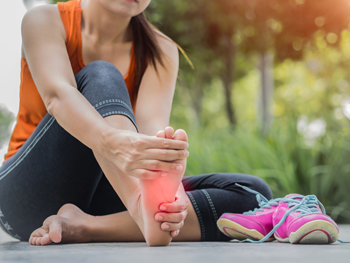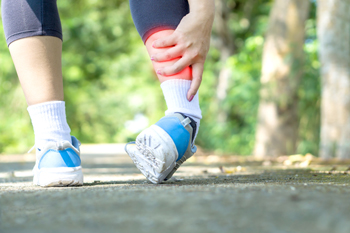Items filtered by date: July 2021
Gout and Diet
 Small urate crystals that can lodge in the joints of the big toe, causing severe pain, can be indicative of gout. Gout is a form of arthritis, and is caused by excess uric acid in the bloodstream. It may develop as a result of genetic factors, or from eating foods that have large amounts of purines. These types of foods can include shellfish, red meat, alcohol, and drinks that are made with sugar. Some of the symptoms that are associated with this ailment consist of pain and swelling in the big toe and surrounding area, and the condition may worsen at night. Patients who have high blood pressure, kidney disease, or who may be obese are more likely to develop gout. Relief may be felt after making positive lifestyle changes, such as dietary modifications that may consist of eating more fruits, vegetables, and drinking plenty of fresh water. If you are afflicted with gout, it is strongly suggested that you are under the care of a podiatrist who can effectively treat this condition.
Small urate crystals that can lodge in the joints of the big toe, causing severe pain, can be indicative of gout. Gout is a form of arthritis, and is caused by excess uric acid in the bloodstream. It may develop as a result of genetic factors, or from eating foods that have large amounts of purines. These types of foods can include shellfish, red meat, alcohol, and drinks that are made with sugar. Some of the symptoms that are associated with this ailment consist of pain and swelling in the big toe and surrounding area, and the condition may worsen at night. Patients who have high blood pressure, kidney disease, or who may be obese are more likely to develop gout. Relief may be felt after making positive lifestyle changes, such as dietary modifications that may consist of eating more fruits, vegetables, and drinking plenty of fresh water. If you are afflicted with gout, it is strongly suggested that you are under the care of a podiatrist who can effectively treat this condition.
Gout is a foot condition that requires certain treatment and care. If you are seeking treatment, contact Elliot T. Udell, DPM from New York. Our doctor will treat your foot and ankle needs.
What Is Gout?
Gout is a type of arthritis caused by a buildup of uric acid in the bloodstream. It often develops in the foot, especially the big toe area, although it can manifest in other parts of the body as well. Gout can make walking and standing very painful and is especially common in diabetics and the obese.
People typically get gout because of a poor diet. Genetic predisposition is also a factor. The children of parents who have had gout frequently have a chance of developing it themselves.
Gout can easily be identified by redness and inflammation of the big toe and the surrounding areas of the foot. Other symptoms include extreme fatigue, joint pain, and running high fevers. Sometimes corticosteroid drugs can be prescribed to treat gout, but the best way to combat this disease is to get more exercise and eat a better diet.
If you have any questions please feel free to contact our office located in Hicksville, NY . We offer the newest diagnostic and treatment technologies for all your foot and ankle needs.
What to Do About Your Toenail Infection
 Toenail infections are very common and are caused by bacteria and fungi growing on or underneath the toenail. These fungi often thrive and grow in warm and moist environments like public pools, locker rooms and showers. Signs of a fungal nail infection include the nail thickening, turning yellow or brown, becoming crumbly, pain or the nail separating from the nail bed. Patients who notice these symptoms should consult with a podiatrist for treatment options, especially diabetic patients since the infection can lead to further complications. Upon visiting a podiatrist, they will check the nail and suggest a treatment option. Common treatment options include antifungal medications, removing the nail, or antifungal nail paints.
Toenail infections are very common and are caused by bacteria and fungi growing on or underneath the toenail. These fungi often thrive and grow in warm and moist environments like public pools, locker rooms and showers. Signs of a fungal nail infection include the nail thickening, turning yellow or brown, becoming crumbly, pain or the nail separating from the nail bed. Patients who notice these symptoms should consult with a podiatrist for treatment options, especially diabetic patients since the infection can lead to further complications. Upon visiting a podiatrist, they will check the nail and suggest a treatment option. Common treatment options include antifungal medications, removing the nail, or antifungal nail paints.
For more information about treatment, contact Elliot T. Udell, DPM of New York. Our doctor can provide the care you need to keep you pain-free and on your feet.
Toenail Fungus Treatment
Toenail fungus is a condition that affects many people and can be especially hard to get rid of. Fortunately, there are several methods to go about treating and avoiding it.
Antifungals & Deterrence
Oral antifungal medicine has been shown to be effective in many cases. It is important to consult with a podiatrist to determine the proper regiment for you, or potentially explore other options.
Applying foot powder on the feet and shoes helps keep the feet free of moisture and sweat.
Sandals or open toed shoes – Wearing these will allow air movement and help keep feet dry. They also expose your feet to light, which fungus cannot tolerate. Socks with moisture wicking material also help as well.
If you have any questions please feel free to contact our office located in Hicksville, NY . We offer the newest diagnostic tools and technology to treat your foot and ankle needs.
What Is Tenosynovitis?
 Tenosynovitis is an inflammation of a tendon and its synovium, or lining. This condition can affect the feet or ankles and occurs due to injury, repetitive overuse, excessive pressure on the tendon, or an infection. Symptoms of tenosynovitis in the lower limbs include pain, redness, or swelling, clicking, locking, or snapping in the affected foot or ankle, a grating sound or feeling, stiffness, weakness, and limited range of motion. When tenosynovitis affects the toes, there may be a noticeable bump on the toe. If you are experiencing the symptoms of this condition anywhere around your feet and ankles, it is suggested that you see a podiatrist for treatment.
Tenosynovitis is an inflammation of a tendon and its synovium, or lining. This condition can affect the feet or ankles and occurs due to injury, repetitive overuse, excessive pressure on the tendon, or an infection. Symptoms of tenosynovitis in the lower limbs include pain, redness, or swelling, clicking, locking, or snapping in the affected foot or ankle, a grating sound or feeling, stiffness, weakness, and limited range of motion. When tenosynovitis affects the toes, there may be a noticeable bump on the toe. If you are experiencing the symptoms of this condition anywhere around your feet and ankles, it is suggested that you see a podiatrist for treatment.
Ankle and foot injuries are common among athletes and in many sports. They can be caused by several problems and may be potentially serious. If you are feeling pain or think you were injured in a sporting event or when exercising, consult with Elliot T. Udell, DPM from New York. Our doctor will assess your condition and provide you with quality foot and ankle treatment.
Common Injuries
The most common injuries that occur in sporting activities include:
- Achilles Tendonitis
- Achilles Tendon Rupture
- Ankle Sprains
- Broken Foot
- Plantar Fasciitis
- Stress Fractures
- Turf Toe
Symptoms
Symptoms vary depending upon the injury and in some cases, there may be no symptoms at all. However, in most cases, some form of symptom is experienced. Pain, aching, burning, bruising, tenderness, tightness or stiffness, sensation loss, difficulty moving, and swelling are the most common symptoms.
Treatment
Just as symptoms vary depending upon the injury, so do treatment options. A common treatment method is known as the RICE method. This method involves rest, applying ice, compression and elevating the afflicted foot or ankle. If the injury appears to be more serious, surgery might be required, such as arthroscopic or reconstructive surgery. Lastly, rehabilitation or therapy might be needed to gain full functionality in the afflicted area. Any discomfort experienced by an athlete must be evaluated by a licensed, reputable medical professional.
If you have any questions, please feel free to contact our office located in Hicksville, NY . We offer the newest diagnostic and treatment technologies for all your foot care needs.
Practical Tips for Preventing Running Injuries
As a runner, taking good care of your feet can help you perform at peak levels while reducing your risks of injury. First and foremost, choose the right running shoes. Get fitted by a professional, and take into consideration your style of running, fitness goals, and the type of terrain you’ll be running on. Get your feet used to new shoes by wearing them around the house first. Wear moisture-wicking socks to keep feet dry and to avoid athlete’s foot and blisters—which can also be prevented by applying petroleum jelly or body glide on areas of friction. Reduce swelling and help your feet and muscles recover by icing and massaging your feet. Keep your toenails trimmed at the right length and straight across to avoid bruised or ingrown toenails. Do strengthening exercises to build up muscles in your feet. For more tips on avoiding running injuries, strengthening foot muscles, and choosing the right shoe for your feet, consult with a podiatrist.
All runners should take extra precaution when trying to avoid injury. If you have any concerns about your feet, contact Elliot T. Udell, DPM of New York. Our doctor will treat your foot and ankle needs.
How to Prevent Running Injuries
There are a lot of mistakes a runner can make prior to a workout that can induce injury. A lot of athletes tend to overstretch before running, instead of saving those workouts for a post-run routine. Deep lunges and hand-to-toe hamstring pulls should be performed after a workout instead of during a warmup. Another common mistake is jumping into an intense routine before your body is physically prepared for it. You should try to ease your way into long-distance running instead of forcing yourself to rush into it.
More Tips for Preventing Injury
- Incorporate Strength Training into Workouts - This will help improve the body’s overall athleticism
- Improve and Maintain Your Flexibility – Stretching everyday will help improve overall performance
- “Warm Up” Before Running and “Cool Down” Afterward – A warm up of 5-10 minutes helps get rid of lactic acid in the muscles and prevents delayed muscle soreness
- Cross-Training is Crucial
- Wear Proper Running Shoes
- Have a Formal Gait Analysis – Poor biomechanics can easily cause injury
If you have any questions, please feel free to contact our office located in Hicksville, NY . We offer the newest diagnostic and treatment technologies for all your foot care needs.


